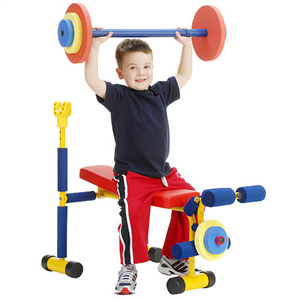The following strength-training program developed for these student athletes is intended to instill
health and wellness through physical fitness. Built on the focus of form, knowledge, and a respect for the weight-room, it instills, at a young age, the notion that a fitness center can be beneficial so long as special attention is given to detail. Children love to play, love to be challenged and love to get better at their sport. As they get older, they will be encouraged to use the weight-room to build size, strength and speed. From experience, I can tell you that at 14-15 years old, walking into my high-school gym, I had no idea about dumbbells or medicine balls. I have learned over the 2 years professionally, and 12 years as a hobby the amazing capabilities a weight-room can give to any individual. Although, it is not a walk in the park, it is most important to be disciplined. For example: to hold good form throughout a lift in order to avoid injury. One must respect that going for big weight before one is ready, or lifting with bad form can result in injury. Additionally, one must get past ego-driven questions, such as: “Who can bench more?” Finally one should learn which lifts can benefit them, and which ones are unnecessary. If, at a decisive age, the weight-room can be demonstrated as a tool for our athletes, rather than as a competition ground, they will make further strides with their sports than they may have without any knowledge at all. Ultimately, all of this knowledge will show what an important and exciting force physical fitness can be in their lives.
Some say that prepubescent weight training can cause epiphyseal fusion (early bone fusion), and ultimately stunting growth. Others go further and say, structurally and hormonally, a prepubescent athlete’s body isn’t ready to weight-train. Although these might be true, in some applications, they only become true if these young athletes are pushing themselves to the same degree as those involved with bodybuilding and/or power-lifting. Strength-training or weight-training on its own does not exist in the same category as weightlifting, bodybuilding or power-lifting. The latter are considered sports: largely driven by competition, with participants trying to lift heavier weights or build bigger muscles than those of other athletes. So long as the two ideas are separate, strength-training, especially sports specific strength-training, can be beneficial for individuals at any age.
Many weight-training institutions, including the American College of Sports Medicine (ACSM) and the National Strength and Conditioning Association (NSCA), consider resistance training to be a safe activity for prepubescent children, with certain limitations. A retrospective review of injuries associated with weight training in pre-pubescent children found that weight training is, in fact, safer than many other sports and activities (Hamill, 1994). Other researchers also support pre-pubescent weight-training. These researchers say the highly technical maneuvers and lifting techniques associated with its practice make it almost impossible to use too much weight too soon, so long as emphasis is placed upon the importance of qualified supervision, in order to limit risk of injury (Faigenbaum & Polakowski, 1999).
Safely conducted strength-training, can offer many benefits to the younger athlete. It must be remembered that these sessions should be supervised, and the training context should be non-competitive. When these guidelines are in place, the following benefits have been demonstrated: increased muscle strength and endurance, sports performance improvement, improved cardio
respiratory function, protection of the child’s muscles and joints from injury associated with other activities, and stronger bones.
It is important to respect the weight-room for the tool it can become for an individual, while keeping a non-competitive, non-ego driven attitude while in a gym. It has also been shown that weight-training can be safe and beneficial for a student athlete even prior to puberty as shown above.







